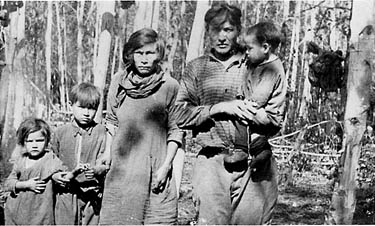
Primitive and modernized North American Indians
NATURE seems to have made one of her large scale demonstrations in the Americas of the power of adaptation of a single racial stock to the scale of climates ranging from torrid jungles of the tropics to the Arctics. The various members of the American Indian race seem clearly to have come from a common origin. The route by which they reached America from Asia as suggested by anthropologists was by way of the Bering Strait. Within a decade a Russian engineer has crossed from Asia to America on the pack ice of the Bering sea, a distance of ninety miles. If this is possible now, how much more likely is it that it has been possible in earlier periods of the world's history, as, for example, during or following the last ice age, or at the time of an earlier ice age. The American Indian, therefore, provides a very remarkable opportunity to study both the capacity for adaptability to different environments and the variations that different environments can produce in a single racial stock. That the Indian of today is not in general a counterpart of the native resident at the time of the discovery of America by Columbus is clearly demonstrated both by the skeletal material and by the early records.
Our problem involved the location and study of groups of the original stock, if such were to be found, who were living in accordance with the tradition of their race and as little affected as might be possible by the influence of the white man. At first thought it might seem impossible that such groups can exist, but as a matter of fact there are still great areas of the American continent inhabited by the original stock living in areas still unexplored. In order to find Indians as little changed as possible by reason of their contact with the white man, particularly with the white man's foods, I went to northern Canada to the region inside the Rocky Mountain range to study the Indians of Northern British Columbia and the Yukon territory. Since an aeroplane could not be used, owing to the lack of a base of supplies for fuel for the return trip; and since the MacKenzie water route was impracticable (an expedition could not go up the waterways through Canada on the MacKenzie River and its branches and return the same season), the route selected was that which enters that territory from Alaska on the large waterway of the Stikine River. This river has cut its channel through the Coast and Cascade Ranges of mountains and has its origin in the high western watershed of the Rockies. It was particularly desirable to reach a group of Indians who could not obtain the animal life of the sea, not even the running salmon. These fish do not enter the waterways draining to the Arctic. We used a high-powered river transport specially designed for going up rapids on the Stikine River to the end of navigation at Telegraph Creek. At this point large quantities of modern foods are stored during the short open navigation season of the summer to be exchanged for furs during the long winter. A Hudson Bay Post has been established at this point. Here a truck was chartered which took us over a trail across the Rocky Mountain Divide to the headwaters of the rivers flowing north to the Arctic. At this outpost two guides were engaged and a high powered scow chartered to make the trip down the waterways toward the Arctic on the Diese and Liard Rivers. This made it possible, in the summer of 1933, to make contact with large bands of Indians who had come out of the Pelly mountain country to exchange their catch of furs at the last outpost of the Hudson Bay Company. Most of the Indians of Canada are under treaty with the Canadian Government whereby that government gives them an annual per capita bounty. This arrangement induces the Indians in the interior to come out to the designated centers to obtain the bounty. Since it is based on the number in the family, all of the children are brought. This treaty, however, was never signed by the Indians of the British Columbia and Yukon Territory. And, accordingly, they have remained as nomadic wandering tribes following the moose and caribou herds in the necessary search to obtain their foods.
The rigorous winters reach seventy degrees below zero. This precludes the possibility of maintaining dairy animals or growing seed cereals or fruits. The diet of these Indians is almost entirely limited to the wild animals of the chase. This made a study of them exceedingly important. The wisdom of these people regarding Nature's laws, and their skill in adapting themselves to the rigorous climate and very limited variety of foods, and these often very hard to obtain, have developed a skill in the art of living comfortably with rugged Nature that has been approached by few other tribes in the world. The sense of honor among these tribes is so strong that practically all cabins, temporarily unoccupied due to the absence of the Indians on their hunting trip, were entirely unprotected by locks; and the valuables belonging to the Indians were left in plain sight. The people were remarkably hospitable, and where they had not been taken advantage of were very kind. Many of the women had never seen a white woman until they saw Mrs. Price. Their knowledge of woodcraft as expressed in skill in building their cabins so that they would be kept comfortably warm and protected from the sub-zero weather was remarkable. Their planning ahead for storing provisions and firewood strongly emphasized their community spirit. When an Indian and his family moved to a camp site on a lake or river, they always girdled a few more trees than they would use for firewood so that there would be a plentiful supply of dry standing timber for future visitors to the camp.
They lived in a country in which grizzly bears were common. Their pelts were highly prized and they captured many of them with baited pitfalls. Their knowledge of the use of different organs and tissues of the animals for providing a defense against certain of the affections of the body which we speak of as degenerative diseases was surprising. When I asked an old Indian, through an interpreter, why the Indians did not get scurvy he replied promptly that that was a white man's disease. I asked whether it was possible for the Indians to get scurvy. He replied that it was, but said that the Indians know how to prevent it and the white man does not. When asked why he did not tell the white man how, his reply was that the white man knew too much to ask the Indian anything. I then asked him if he would tell me. He said he would if the chief said he might. He went to see the chief and returned in about an hour, saying that the chief said he could tell me because I was a friend of the Indians and had come to tell the Indians not to eat the food in the white man's store. He took me by the hand and led me to a log where we both sat down. He then described how when the Indian kills a moose he opens it up and at the back of the moose just above the kidney there are what he described as two small balls in the fat. These he said the Indian would take and cut up into as many pieces as there were little and big Indians in the family and each one would eat his piece. They would eat also the walls of the second stomach. By eating these parts of the animal the Indians would keep free from scurvy, which is due to the lack of vitamin C. The Indians were getting vitamin C from the adrenal glands and organs. Modern science has very recently discovered that the adrenal glands are the richest sources of vitamin C in all animal or plant tissues. We found these Indians most cooperative in aiding us. We, of course, had taken presents that we thought would be appreciated by them, and we had no difficulty in making measurements and photographs, nor, indeed, in making a detailed study of the condition of each tooth in the dental arches. I obtained samples of saliva, and of their foods for chemical analysis. A typical Indian family in the big timber forests in shown in Fig. 15.

The condition of the teeth, and the shape of the dental arches and the facial form, were superb. Indeed, in several groups examined not a single tooth was found that had ever been attacked by tooth decay. In an examination of eighty-seven individuals having 2,464 teeth only four teeth were found that had ever been attacked by dental caries. This is equivalent to 0.16 per cent. As we came back to civilization and studied, successively, different groups with increasing amounts of contact with modern civilization, we found dental caries increased progressively, reaching 25.5 per cent of all of the teeth examined at Telegraph Creek, the point of contact with the white man's foods. As we came down the Stikine River to the Alaskan frontier towns, the dental caries problem increased to 40 per cent of all of the teeth.
Careful inquiry regarding the presence of arthritis was made in the more isolated groups. We neither saw nor heard of a case in the isolated groups. However, at the point of contact with the foods of modern civilization many cases were found including ten bed-ridden cripples in a series of about twenty Indian homes. Some other affections made their appearance here, particularly tuberculosis which was taking a very severe toll of the children who had been born at this center. In Fig. 16 are seen two typical cases of tubercular involvement of glands of the neck. The suffering from tooth decay was tragic. There were no dentists, no doctors available within hundreds of miles to relieve suffering.
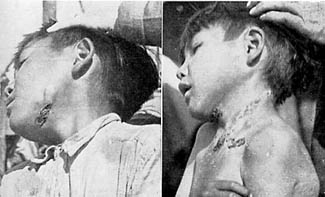
The physiques of the Indians of the far north who are still living in their isolated locations and in accordance with their accumulated wisdom were superb. There were practically no irregular teeth, including no impacted third molars, as evidenced by the fact that all individuals old enough to have the molars erupted had them standing in position and functioning normally for mastication. The excellence of the dental arches is shown in Fig. 17. Where the Indians were using the white man's food tooth decay was very severe, as shown in Fig. 18. In the new generation, after meeting the white civilization and using his foods, many developed crooked teeth, so-called, with deformed dental arches, as seen in Fig. 19.
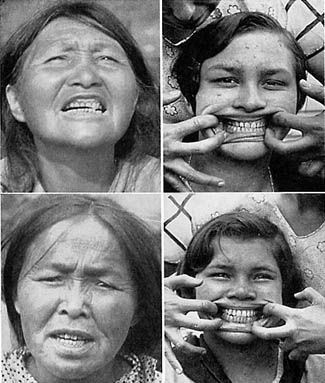
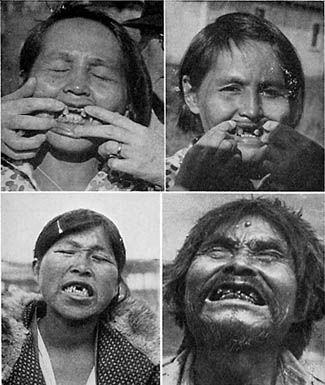
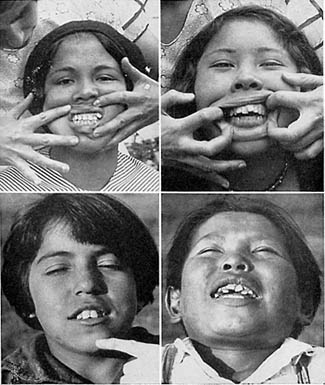
Contact was also made with representatives of relatively isolated primitive Indian stocks in the district south of Hudson Bay. These groups were reached by a newly projected railroad extending eastward and northward from Winnipeg, Manitoba, and we were thus brought into contact with the Indians that had come out of the waterways draining the Hudson Bay and from as far north as James Bay. They had come down to dispose of their furs in exchange for ammunition, blankets, etc. Since this contact was made only once or twice a year, it was quite impossible for the Indians to carry back a sufficient quantity of the foods of the white man to have great influence on their total diet for the year. They still lived on the wild animal game of the land. As in the northern country just reviewed, their principal large animal was the moose. These are treaty Indians, and many of them come out to this frontier to obtain the government bounty and, accordingly, were obliged to bring their families. The bounty here amounted to five dollars per head, a considerable income in exchange for blankets and other equipment. Some of these contact points were at the height of the land dividing the waters running north and east to James Bay and Hudson Bay, or south to Lake Superior. This was historic country that had been the meeting ground of the tribes of the northern waters with the tribes of the Great Lakes district. Many battles had been fought there. For comparison with these more primitive groups from the Hudson and James Bay watershed, I had the opportunity here of studying families that had taken up residence along the railroad or in its vicinity in order that they might have the advantage of exchanging furs for the modern white man's foods. This gave us an excellent opportunity to study the effects of the modern dietary, of which an example is shown in Fig. 20. This Indian and his wife had built their bodies before the contact with the white man. He is about six feet tall. Both the parents had splendid dental arches and well formed faces. His teeth are shown in Fig. 20 (upper, left). Their two children shown in the photograph were born after the adoption of the white man's foods brought in by the railroad. Both are mouth-breathers and both have narrow dental arches and marked underdevelopment of the middle third of the face. The older girl has tuberculosis. Another adult man is shown in Fig. 20 (upper, right). He, like the generation he represents, has exceptionally fine dental arches and well developed face.
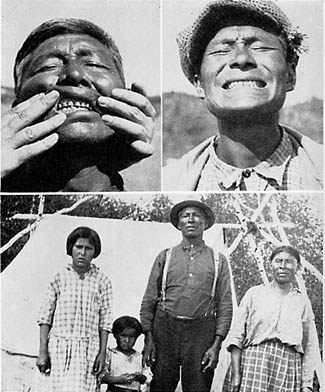
At this point we again found many of the younger generation ill with tuberculosis or crippled with arthritis. Two of these are shown in Fig. 21.

For further comparison of the more isolated and more highly modernized groups a study was made of the Indians in the largest single Indian Reservation in Canada, which is located at Brantford, Ontario. In this group there are about 4,700 Indians living under highly modernized conditions provided by the Canadian Government. They live on very fertile land and in close proximity to a modern Canadian city. Each head of a family is provided with a tract of land from which he usually has an income sufficient to permit him to have an automobile. They were able to buy not only necessities and comforts according to the modern standards of the white man, but many of the luxuries as well. The government provides a well administered hospital and staff. When I asked the Director of this hospital, Dr. Davis, what the principal use of the hospital was at that time (1933), he said that the demand for beds had completely changed in the twenty-eight years he had been there. The principal services requested at the hospital in 1933 related to the problems of maternity. He stated that in his period of contact he had seen three generations of mothers. The grandmothers of the present generation would take a shawl and either alone or accompanied by one member of their family retire to the bush and give birth to the baby and return with it to the cabin. A problem of little difficulty or concern, it seemed. He stated that today the young mothers of this last generation are brought to his hospital sometimes after they have been in labor for days. They are entirely different from their grandmothers or even mothers in their capacity and efficiency in the matter of reproduction. He stated that that morning he had had two cases in which surgical interference was necessary in order to make birth possible.
We had an opportunity here to study the effects of modernization. Indians are great lovers of sports, particularly of their own national game which is lacrosse. We were able to witness one of these contests with a team from another reservation. Indian families came in modern automobiles dressed in modern clothes and purchased pop and candy and modern confections at typical confection stands. These were highly modernized Indians.
The group on this reservation, comprising approximately four thousand seven hundred Indians, belong to the following tribes: Mohawks, Onondagas, Cayugas, Senecas, Oneidas and Delawares making up the Six Nation or Iroquois group. A later addition to this group has been the Tuscaroras from the Carolinas. While there were many mixed bloods, there were also a goodly number of full-blooded Indian families, so that there was an opportunity to study comparatively the effects of intermingling of the Indians with the whites. As in previous investigations, a special effort was made to study the children from eight to sixteen years of age. Typical cases were selected from different environments. For example, boys and girls selected from a training school called Mohawk Institute, which was near the city of Brantford, represented one type of environment. There are approximately one hundred and sixty students under training here, and we were informed that they study half a day and work half a day. The boys are taught craftsmanship and farming, the girls, home economics and garment making, and such practical training as would prepare them for later home building. While most of the boys and girls come from that reservation, a few are accepted from other reservations. It is of interest that 77 per cent of the children in this Institution had suffered from earlier dental caries and that 17 per cent of all the teeth examined had already been attacked by dental caries. But this had occurred apparently before their entrance to the Institute, for we did not find a single case of active caries among those examined, and this is particularly important in connection with their excellent nutrition. The Institute maintained a fine dairy herd and provided fresh vegetables, whole wheat bread, and limited the sugar and white flour.
The children of this group were compared with children of approximately the same age in a public school of the reservation where it was found that 90 per cent had had dental caries, and that at present in 70 per cent of the cases the caries was apparently active. It is important to note that in this group 28.5 per cent of all the teeth examined had already been attacked by tooth decay.
A study was made of patients at the reservation hospital where free service of all kinds is provided. We found that 83 per cent had suffered from dental caries, and that 23.2 per cent of all teeth had already been attacked by caries.
We were particularly interested in the conditions obtaining in the homes, especially with the mothers. A typical young mother had approximately half her teeth attacked by dental caries, as had also her son, aged seven. The middle third of his face was underdeveloped and all of his upper anterior teeth were decayed to the gum line.
A study was made of an Indian reservation in New York State for comparison and for making an estimate of typical modern American Indian life with regard to dental caries and nutrition. For this study a band of 450 in the Tuscarora Reservation northeast of Niagara Falls was visited. Here again we were fortunate to see the people in holiday mood since the study was made on Decoration Day and events of the year had been scheduled, a lacrosse match and a baseball game, between the Indians' teams and white teams from adjacent towns. Several hundred Indians were congregated to exhibit their best in wearing apparel, transportation equipment, and physical prowess. There was evidence of a similarity of features in the older Indians who had not been highly modernized, and a striking deficiency in the facial development of many of the moderns.
A typical mother was studied at her home. She had four children. Her teeth were ravaged by dental caries. She was strictly modern, for she had gold inlays in some of her teeth. The roots of the missing teeth had not been extracted. Twenty of her teeth had active dental caries. Her little girl, aged four, already had twelve very badly carious teeth. Another daughter aged eight had sixteen carious teeth, and her son aged ten had six. The husband was in bed from an acute lung involvement, doubtless tuberculosis. The children were eating their noon day meal when we arrived, which consisted of a white bread and some stewed vegetables. Milk was available for only the small baby in arms. In this Tuscarora group 83 per cent of those examined had dental caries and 38 per cent of all teeth had already been attacked by dental caries. Every one studied in this reservation was using white-flour products, none were using milk liberally, and only a few in even limited amounts. I was told that in both reservations a few years ago the Indians grew wheat and kept cows to provide a liberal supply of natural cereal and milk for their families, but of late this practice had been discontinued. They were now buying their wheat in the form of white flour and their vegetables largely put up in cans. In both reservations they were using commercial vegetable fats, jams and marmalades, sweetened goods, syrups and confections very liberally. It is remarkable how early the child life adopts modern civilization's confections.
In order to provide a further cross section of the modernized Indians of North America, I made a study in a reservation on Winnipeg Lake in Manitoba. This reservation lies north and east of Winnipeg and is quite highly modernized.
These people were reached with much difficulty because of the natural protection provided by the location of their reservation at the mouth of Brokenhead River. They had been provided with fertile lands and taught modern methods of farming. Their proximity to a great body of water fairly well-stocked with fish gave them an opportunity to secure fish, if they were disposed to make the effort to do so, as their ancestors had done through previous centuries. Their homes were found to be in a dilapidated condition, and while their lands were stocked with cattle and horses, such as we found were in poor condition, and limited in number. The people had been provided with a government school and a government agent to assist in providing for their needs and in giving material assistance when needed. They were within fairly easy distance of hospitals, and had available modern medical service. Notwithstanding all these advantages, their physical condition was very poor. Dental caries was so wide-spread that 39.1 per cent of all teeth studied were found to be affected. They were living almost entirely on modern foods, imported white flours, jams, canned vegetables and liberal quantities of sugar. Over 90 per cent of the individuals had rampant dental caries. Their physical condition and their supply of necessities was very much lower than was that of either of the two preceding groups. Distress was evident even in late summer.
The Indians so far reported were living inland with access to inland foods only. The Pacific Coast Indians were examined to determine the effect of sea foods. To find evidence relating to the physical, and particularly to the dental condition of the Indians who inhabited the Pacific slope a thousand or more years ago, a visit was made to the Vancouver Museum at Vancouver which fortunately possesses splendidly preserved specimens of prehistoric periods. Some of these skulls were uncovered while cutting through a hill for a street extension in the city of Vancouver. Above was a virgin forest of large size green firs and underneath them in the soil there were preserved fallen trunks of other large trees. Several feet below these, burials were uncovered containing skeletons of an early Indian race. This collection contains also skulls from several places and from prehistoric periods. The teeth are all splendidly formed and free from dental caries. The arches are very symmetrical and the teeth in normal and regular position.
It was important to study the conditions of their successors living in the same general community. Accordingly, we examined the teeth and general physical condition of the Indians in a reservation in North Vancouver, so situated that they have the modern conveniences and modern foods. In this group of children between eight and fifteen years of age, 36.9 per cent of all the teeth examined had already been attacked by dental caries. No people were found in this group who were living largely on native foods.
Vancouver Island with its salubrious climate is one of the most favored places of residence on the Pacific Coast. It was of particular interest to study the Indians near Victoria on this island in the Craigflower Indian Reservation. Indeed, the city of Victoria has been partly built on the original Craigflower Indian Reservation. As the need became acute for the territory reserved for them, an arrangement was consummated whereby the Indians were induced to exchange that land for new land in an adjoining district in which a new house was built free for each family. Besides a house, an allotment of land and a sum of money, reported to be ten thousand dollars, was given to each family. This allowed them to become very modern, and, accordingly, many of them owned automobiles and other modern luxuries. The physical effects of the use of food luxuries, resulting from ample funds for purchasing any foods that they might desire, was marked. They were in close proximity to skilled dental service and had practical training in oral prophylaxis. Notwithstanding this, 48.5 per cent of all teeth examined had already been attacked by dental caries. Every individual examined was suffering from tooth decay. The original diet of the Indians of the Pacific Coast was, as we shall see, very largely sea foods, which are probably as abundant today as ever before. It would require a real urge to go to catch the fish since they can now be purchased canned in the open market. Like most modern people, they were living on white-flour products, sweet foods and pastries.
Probably few cities of the Pacific Coast have had a greater abundance and variety of edible sea foods, particularly the various kinds of salmon, than Ketchikan. It is beautifully located on an island, and is the most southerly city in Alaska. Among the many fish that are abundant along this part of the Pacific Coast is the oolachan or candle fish. It is a small fish, but very rich in oil; so much so that it gets its name from being burned as a candle for light. This oil is collected in large quantities and used as a dressing for many of their sea foods. It is also traded with the Indians of the interior for furs and other products. An Indian settlement in this city was studied and it was found that 46.6 per cent of all teeth examined had already been attacked by tooth decay. In many of the homes individuals were ill with tuberculosis or arthritis. Tuberculosis had robbed many of the homes of one or more of its children.
At Juneau, the capital of Alaska, two groups were studied; one in the government hospital, and the other in an Indian settlement. In the hospital were both Indians and Eskimos, chiefly the former. Seventy-five per cent of the patients were reported to have been brought because they had tuberculosis, and some who had come because of accident and other conditions were reported to have tuberculosis also. Approximately 50 per cent of the total hospital enrollment was under 21 years of age. The dental conditions were bad, for 39.1 per cent of all the teeth examined had been attacked by tooth decay.
In the Indian settlement, a group of elderly primitives was found, every one of whom had complete dentitions in normal arrangement of the arches and without dental caries. In a settlement of modern Indians living principally on modern foods 40 per cent of all teeth had been attacked by tooth decay.
At Sitka, the former capital, two important groups were studied. Located here is the Sheldon Jackson School for Eskimos and Indian boys and girls, chiefly Indians. They have come from widely scatterd territory throughout Alaska, and represent the finest physical specimens that can readily be secured for giving the advantages of an education. Of necessity they came very largely from the modernized districts. In this group 53.7 per cent of all the teeth examined had already been attacked by tooth decay. This gives an indication of the dental conditions in the large number of modernized districts which they represented.
In a settlement at Sitka, a group of Indians of various ages were studied, and it was found that 35.6 per cent of all their teeth had already been attacked by dental caries. A well preserved native Indian, seventy years of age, was found who had come into town from another district. He stated that his diet had consisted chiefly of fish, fish eggs, seaweed and deer. His teeth were of very high excellence and were entirely free from past or present dental caries. He is a splendid example of the product of the native dietary provided for the Pacific Coast people of any period or stage of civilization.
The local physician at Sitka kindly gave very valuable information relative to the attitude of the native Indians in the matter of obtaining fresh sea foods when foods that were very satisfying could be so easily obtained in concentrated form at the various stores. They could go to one of the piers at almost any time of the year and catch fish or secure them as they had been accustomed to do before the arrival of modern foods, but there is a constant striving to be like and live like the white people. They seem to think it is a mark of distinction to purchase their foods and that it is degrading to have to forage for one's foods. They very readily come to depend on white flour and sugar, jams and canned vegetables; and much prefer to have the government or charitable organization supply these when they cannot purchase them, rather than go out and secure their own nutrition. This physician stated that there were about 800 whites living in the town and about 400 Indians, and that notwithstanding this difference in numbers there were twice as many Indian children born as white children, but that by the time these children reached six years of age there were more white children living than Indian and half-breed children. This he stated was largely due to the very high child mortality rate, of which the most frequent cause is tuberculosis. While it does not take many decades to record a distinct physical deterioration, a deteriorating parenthood greatly speeds up this process. While physical defects acquired by the parent will not be transmitted as such, prenatal deficiencies may be established because of the physical defects of the mother resulting from her faulty nutrition, and these deficiencies, together with disturbed nutrition of infancy and early childhood will go far in determining whether there will be for the child a physical breakdown or whether the normal defense of the body will be adequate to protect it from various infections to which it may later be exposed.
Sitka has furnished the longest history of contact with white men of almost any community on the Pacific Coast. Indeed, it was a famous seaport long before any United States Pacific Coast communities had been established. It is of much interest that it was a shipbuilding center for vessels in the Russian trade. Its foundries were developed so efficiently that the bells of the early monasteries of California were cast in this town by the Russians. It contains some of the best examples of the early Russian architecture, particularly in its cathedral.
Anchorage is the principal city of western Alaska, since it is not only a base for the railroad running north to Fairbanks, but a base for aeroplane companies operating throughout various parts of Alaska. It is accordingly a combination of a coast city with its retail activities and a wholesale base for outfitters for the interior. It has an excellent government hospital which probably has been built around the life of one man whom many people told us was the most beloved man in all Alaska. He is Dr. Josef Romig, a surgeon of great skill and with an experience among the Eskimos and Indians, both the primitives and modernized, extending over thirty-six years. I am deeply indebted to him for much information and for assistance in making contacts. He took me, for example, to several typically modernized Indian homes in the city. In one, the grandmother, who had come from the northern shore of Cook Inlet to visit her daughter, was sixty-three years of age, and was entirely free from tooth decay and had lost only one of her teeth. Her son, who had accompanied her, was twenty-four years of age. He had only one tooth that had ever been attacked by tooth decay. Their diet had been principally moose and deer meat, fresh and dried fish, a few vegetables and at time some cranberries. Recently the son had been obtaining some modern foods. Her daughter, twenty-nine years of age, had married a white man and had had eight children. She and they were living on modern foods entirely. Twenty-one of her thirty-two teeth had been wrecked by dental caries. Their diet consisted largely of white bread, syrup and potatoes. Her children whom we examined ranged from five to twelve years of age, and in that family 37 per cent of all the teeth have already been attacked by dental caries, notwithstanding the young age of the children. The mother of this family is shown in Fig. 18 (upper, left). It is of great importance that not only was dental caries rampant, but that there were marked deformity of the dental arches and irregularity of teeth in the cases of the children.
Among the many items of information of great interest furnished by Dr. Romig were facts that fitted well into the modern picture of association of modern degenerative processes with modernization. He stated that in his thirty-six years of contact with these people he had never seen a case of malignant disease among the truly primitive Eskimos and Indians, although it frequently occurs when they become modernized. He found similarly that the acute surgical problems requiring operation on internal organs such as the gall bladder, kidney, stomach, and appendix do not tend to occur among the primitive, but are very common problems among the modernized Eskimos and Indians. Growing out of his experience, in which he had seen large numbers of the modernized Eskimos and Indians attacked with tuberculosis, which tended to be progressive and ultimately fatal as long as the patients stayed under modernized living conditions, he now sends them back when possible to primitive conditions and to a primitive diet, under which the death rate is very much lower than under modernized conditions. Indeed, he reported that a great majority of the afflicted recover under the primitive type of living and nutrition.
The institutions that have been organized for the care of orphans and for the education of Eskimo and Indian boys and girls provide an opportunity to study conditions. A particularly favorable institution is located at Eklutna on the railroad north of Anchorage. Many of the individuals in the school had come from districts so remote from transportation facilities that their isolation had compelled them to live mostly on native foods, at least during their early childhood. They had come from districts very widely distributed throughout the Alaskan peninsula. Credit is due to the management of this institution for preparing and storing dried salmon for use throughout the winter. The beneficial effects of their good nutritional program were evident. The percentage of teeth attacked by dental caries was 14.6. A large percentage of these pupils were of mixed blood of native Eskimos or Indians with whites. The white parent had probably been largely responsible for their attendance at this training school. There were several full-blooded Eskimos and Indians from modernized communities where they had been living on modern foods throughout their entire lifetime. This gave an opportunity to study the rôle of nutritional deficiencies in the development of deformities and irregularities in the facial features, in the arrangement of the teeth, and in the inter-relationship between the dental arches. The typical irregularities and divergencies from normal were present in the full-blooded Eskimo and Indian boys and girls in as high percentage as in the mixed bloods. Some of the young people with parentage of mixed blood have beautiful features.
Another important institutional group was studied at Seward in the Jesse Lee Home which had first been established at Nome and had been moved to Seward to avoid the extreme isolation of that district. This institution is located at Resurrection Bay which is one of the most beautiful harbors in the world. It gives shelter and educational opportunities to Eskimos and Indians, chiefly of mixed blood, from a large area of Alaska, and particularly from the Aleutian Peninsula, the Aleutian Islands and the Bering Sea. These individuals, whether of mixed or pure blood, had come chiefly from homes that were in large part modernized. The incidence of dental caries found here was 27.5 per cent for all teeth examined. Here again all individuals were affected. Notwithstanding the unusually fine hygienic conditions and highly trained dietitians of this institution, a medical ward and trained nurses, tuberculosis was reaping a heavy toll. I was told that 60 per cent of all those students who had moved with the school from Nome to this location were already dead from tuberculosis. It is common knowledge that tuberculosis has played a very important rôle in decimating the Indian and Eskimo population in the Pacific Coast towns and villages. A very important phase of these investigations is the development of new light on the rôle of nutrition in lowering the defense of these individuals so that with their low inheritance of defensive factors they rapidly become susceptible to tuberculosis.
The problem of evaluating the influence of a particular environment on racial and tribal development is relatively simple when studying contemporary remnants of primitive racial stocks. However, groups that have lived and disappeared in the past do not permit of so simple a procedure for making physical estimates. Fortunately, we have in the burial grounds not only the skeletons, but also many of the implements used in daily life. Sometimes these contain samples of the foods. We may find also their art ware and hunting equipment. While the period may not be definitely recorded, the knowledge of the history of the pottery of the tribe often gives an important clue to the dates as will also the method of burial. Burials made before the advent of the Christian era will in many groups show the bodies in a flexed position with the arms in the lap, whereas in the Christian burials the bodies have been laid prone and the arms crossed on the chest. By this sign the pre-Columbian burials can readily be separated from the post-Columbian.
Using these guides, a study of the Indians of Florida, past and present, permits of comparing the pre-Columbians with those living today in that same territory. We will, accordingly, consider the dental caries problem and that of facial and dental arch form in the Florida Indians by comparing three groups: namely, the pre-Columbian, as evidenced from a study of the skull material in the museums; the tribes of Indians living in as much isolation as is possible in the Everglades and Cypress Swamps; and the Indians of the same stock that are living in contact with the foods of modern civilization. This latter group lives along the Tamiami trail and near Miami. In a study of several hundred skulls taken from the burial mounds of southern Florida, the incidence of tooth decay was so low as to constitute an immunity of apparently one hundred per cent, since in several hundred skulls not a single tooth was found to have been attacked by tooth decay. Dental arch deformity and the typical change in facial form due to an inadequate nutrition were also completely absent, all dental arches having a form and interdental relationship such as to bring them into the classification of normal. These are illustrated in Figs. 22 and 23. The problem of reaching the isolated groups living in the depth of the Cypress Swamps was complicated by the fact that these people had a dread of all whites growing out of their belief that they had been grossly taken advantage of in some of their early efforts to make a treaty with the whites. With the assistance of three guides, one, an Indian of their own group, another, a white man whom they trusted, and the third, a government nurse who had been very helpful in case of sickness, we were able to take the desired measurements and records and photographs. A group of these more primitive representatives is shown in Fig. 24. While their hunting territory had been grossly encroached upon by the white hunters, they were still able to maintain a very high degree of physical excellence and high immunity to dental caries. Only four teeth in each hundred examined were found to have been attacked by tooth decay.

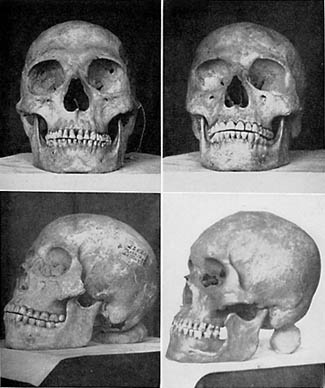
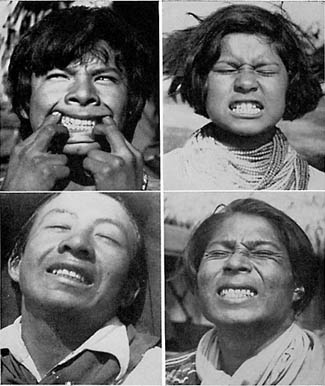
Practically all of the dental arches were normal in contour with freedom from facial distortion. In contrast with this, the Indians of Florida who are living today in contact with modern civilization present a pathetic picture. Forty out of every hundred teeth examined were found to have been attacked by tooth decay, typically illustrated in Fig. 25. In the latest generation, many dental arches showed a typical deformation with crowding of the teeth and narrowing of the face, conditions that have been found in all human stocks when on an inadequate nutrition during the formative and early growth period. A group of these is typically illustrated in Fig. 26.
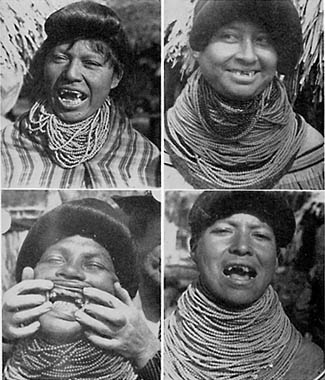

It is of interest that the quality of the skeletal material that is taken from the mounds showed unusually fine physical development and freedom from joint involvements. In contrast with this, many of the individuals of the modernized group were suffering from advanced deformities of the skeleton due to arthritic processes.
The effects of the excellent nutrition of the pre-Columbian Indians is indicated in the comparative thickness of the skulls. In Fig. 27 are shown two pieces of a pre-Columbian skull in contrast with a modern skull. The specimen of a trephined lower jaw, shown in Fig. 27 (right) indicates a knowledge of surgery that is very remarkable. The margins show new bone growth. The operation opened a cyst.
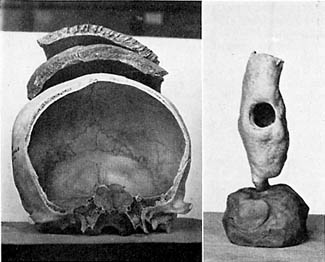
For the study of a group of Indians now living in a high western state, Albuquerque, New Mexico, was visited.
Several other Indian studies have been made including studies of living groups, recently opened burials and museum collections, all of which support the findings recorded here. I am indebted to the directors and to the staffs of these institutions for their assistance.
Notwithstanding the wide range of physical and climatic conditions under which primitive Indians had been living, their incidence of tooth decay while on their native foods was always near zero; whereas, the modernized Indians of these groups showed very high incidence of dental caries. A summary of percentages follows: Primitive Indians: Pelly Mountain, 0.16 per cent; Juneau, 0.00 per cent; Florida Pre-Columbian, 0.00 per cent; Florida Seminoles, 4.0 per cent. Modernized Indians: Telegraph Creek, 25.5 per cent; Alaska Frontier, 40.0 per cent; Mohawk Institute, 17 per cent; Brantford Reservation Public School, 28.5 per cent; Brantford Reservation Hospital, 23.2 per cent, Tuscarora Reservation, 38.0 per cent; Winnipeg Lake Reservation, 39.1 per cent; North Vancouver Reservation, 36.9 per cent; Craigflower Indian Reservation, 48.5 per cent; Ketchikan, 46.6 per cent; Juneau Hospital, 39.1 per cent; Sheldon Jackson School, 53.7 per cent; Sitka, 35.6 per cent; Eklutna, 14.6 per cent; Jessie Lee Home, Seward, 27.6 per cent, and Florida Seminoles, 40.0 per cent.
The foods used by the primitives varies according to location and climate. The foods of the modernized groups in all cases were the typical white man's foods of commerce.
While the primitive groups constantly presented well-formed faces and dental arches reproducing the tribal pattern, the new generation, after the adoption of white man's foods, showed marked changes in facial and dental arch form.
The Indians like several primitive races I have studied are aware of the fact that their degeneration is in some way brought about by their contact with the white man. The dislike of the American Indian for the modern white civilization has been emphasized by many writers. In my studies among the Seminole Indians of Florida I found great difficulty in communicating with or making examination of the isolated Seminoles living deep in the Everglades and Cypress Swamp. Fortunately, I had the able assistance of one of their own tribe, a government nurse who had been very helpful to them and also a white man who had befriended them and whom they trusted. With their assistance I was able to carry out very detailed studies. It was of interest, however, that when we arrived at a settlement in the bush we practically always found it uninhabited. Our Indian guide would go into the surrounding scrub and call to the people assuring them it was to their advantage to come out, which they finally did. I was told that this attitude had grown out of the belief on their part that their treaties had been violated. These isolated Seminole Indian women had the reputation of turning their backs on all white men.
A United States Press report (1) provides an article with the heading "Tribes 'Fed Up' Seek Solitude, Indians Dislike Civilization, Ask Land Barred to White Men." The article continues:
The Bureau of Indian Affairs revealed today that five Indian tribes in Oklahoma are "fed up" with white civilization and want new, secluded tribal lands.
So widespread is the discontent among the 100,000 Indians living in Oklahoma, officials said, that serious study is being given to the possibility of providing new lands where the redman may hunt and fish as his ancestors did.
Dissatisfaction has been brewing for a long time as a result of an increasing Indian population, decreasing Indian lands and unsatisfactory economic conditions. It was brought officially to the notice of bureau officials several days ago when a delegation, headed by Jack Gouge, a Creek Indian from Hanna, Okla., told Indian Commissioner John Collier that most of the Oklahoma Indians wanted new tribal lands away from white civilization.
So anxious are his people to escape from the white man and his influences, Jack Gouge said, that an organization of about 1000 Indians has been formed to press the demands. It is known as the "Four Mothers," apparently representing four of the "civilized tribes"--the Creeks, Choctaws, Cherokees and Chickasaws.
The fifth civilized tribe, the Seminoles of Oklahoma, are negotiating with the Mexican government for tribal lands in that country.
These tribes are described as "civilized" because of the high degree of culture they attained in their original tribal lands along the eastern coast. As their eastern lands became valuable the Indians were moved to the area which is now Oklahoma. At the turn of the century, however, with the discovery of oil there the new tribal lands were broken up. The Indians were forcibly removed to small tracts despite their desire to remain together. Indian Bureau officials do not conceal their bitterness over the white man's "treachery." One official pointed out that about 300 treaties have been signed with the Indians and that practically every one has been violated.
It will be most fortunate if in the interest of science and human betterment such a program as this will be carried out in order to permit these Indians to live in accordance with the accumulated wisdom of their various tribes. Their preservation in isolation would preserve their culture. The greatest heritage of the white man today is the accumulated wisdom of the human race.
Reference
Next
Table of Contents
Back to the Small Farms Library